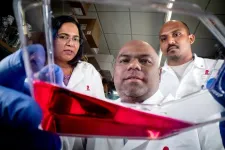(Press-News.org) Residential treatment is among the most effective tools for treating substance use disorder, with people in these settings showing improvement not only in their substance use but also in their mental health, social functioning and quality of life. However, when people leave residential substance use facilities, they face immense challenges as they attempt to reintegrate into their communities and return to their normal lives.
As many as 40 to 70 percent of people who complete residential treatment return to using substances shortly after discharge, according to University of Rhode Island psychology Associate Professor Nicole Weiss. People are thrust back into a world where substances are again readily available to them. They may return to previous routines and social networks that challeng their recovery goals. Many face economic or housing instability, increasing stress, which may lead them to return to substances as a means of coping. Most who return to use do so within the first week, Weiss said.
“These findings signal a need for research that can help us identify high-risk states for return to use, as well as factors that can attenuate that risk during re-entry,” said Weiss, who leads a study funded by a $3.5 million grant from the National Institute on Drug Abuse with researchers at Brown University, the University of Connecticut and Rutgers University. “We know residential treatment is effective in reducing substance use, but we have seen that this period of community re-entry challenges those gains. We hope to develop an evidence-based tool to help prevent a return to substance use.”
Weiss will recruit 300 individuals to take part in the study as they leave residential treatment facilities. For 30 days, each participant will wear a biosensor, similar to a Fitbit, which will continuously measure physiological signs like heart rate, perspiration, and temperature. Weiss is particularly interested in heart rate variability, which is involved in the regulation of behavioral, cognitive, and emotional responses, and may be a key bio-signal for detecting risk for return to substance use.
“If our hypotheses are correct and heart rate variability predicts return to use, this may indicate the utility of wearable biosensors. Such a tool could vastly improve clinical decision making, allowing for early intervention,” Weiss said.
Participants will also answer questions on a smartphone app about their experiences in that moment—who they are with, what they are doing—their cravings for substances, and their psychological responses, including emotions, coping methods, and any mental health challenges they may be experiencing.
“It's important to merge the biosensor data with information about the individual in those moments,” Weiss said. “We can better understand why they’re having the physiological responses we are observing. We’re hoping that data will improve our prediction models and ultimately inform tools that can help us better detect return to substance use.”
After 30 days, participants will visit Weiss’ STRESS lab in Providence, where they’ll be asked about the period of community re-entry, including what types of treatments and services they think people need to be successful, and what barriers keep people from accessing those treatments and services. The information will directly inform the development of resources and tools for this high-risk period of community re-entry.
“We are centering the voices of individuals who have lived experiences of substance use, and leveraging the knowledge they share to inform our future work in this area,” Weiss said. “There is a lot of variability in people’s experiences following residential treatment. If we think of substance use risk as constantly changing and appearing without warning to an individual, we can really see the utility of a person having access at their fingertips to a tool that can provide them with the immediate resources and supports they need. Given the extensive barriers they face, it is important to develop novel, low-barrier tools to assist them in their recovery.”
END
URI study examines challenges, barriers to care for individuals leaving residential substance use facilities
Using biosensors and psychological self-reports, research aims to inform interventions to help prevent return to substance use
2024-06-14
ELSE PRESS RELEASES FROM THIS DATE:
Some CRISPR screens may be missing cancer drug targets
2024-06-14
CRISPR/Cas9 gene editing has made possible a multitude of biomedical experiments including studies that systematically turn off genes in cancer cells to look for ones that the cancer cells heavily depend on to survive and grow. These genes, or “cancer dependencies,” are often promising drug targets. But new research shows that many of these CRISPR screening experiments rely on components, called CRISPR/Cas9 guides, that do not perform equally well in cells from people of all ancestries, which can cause CRISPR screens to miss cancer dependencies.
These CRISPR guides are short sequences of RNA that ...
$18.5 million U19 grant will study B and T memory cells in transplanted lungs, uteruses and kidneys
2024-06-14
BIRMINGHAM, Ala. – Memory immune cells reside in many tissues, poised to react to a second infection or continuing antigen. Yet little is known about these tissue-resident memory cells — how they get there, how they evolve and how they compete in tissues.
A five-year, $18.5 million grant will allow University of Alabama at Birmingham researchers to investigate T and B tissue-resident memory cells, known as TRM and BRM cells, in three unique sites — transplanted lungs, transplanted kidneys and the transplanted ...
Improving soil health yields unexpected benefits for farmers
2024-06-14
In the U.S., as farmers wrestle with extreme heat and drought, heavy rainfall and flooding, and erosion—all factors of climate change which can take a toll on crops—there's been a lot of buzz over regenerative agriculture over the past few years, as big agriculture companies promise opportunities to make money from "carbon farming" while also improving soil health.
Regenerative farming strives to improve soil health through various methods, including reduced or no tillage, keeping the soil covered year-round through ...
NYCST announces inaugural awards for space technology projects
2024-06-14
The New York Consortium for Space Technology (NYCST) is led by Cornell University, which is funded by the U.S. Department of Defense’s Office of Local Defense Community Cooperation through the Defense Manufacturing Community Support Program.
Ithaca, NY— June 14, 2024 — The New York Consortium for Space Technology Innovation and Development (NYCST) today announced more than $300 thousand has been allocated to support 6 projects through the inaugural round of the consortium’s funding program. The projects were selected during NYCST’s inaugural ...
St. Jude scientists solve decades long mystery of NLRC5 sensor function in cell death
2024-06-14
(MEMPHIS, Tenn. – June 14, 2024) The innate immune system is responsible for protecting the human body from threats that could cause disease or infection. The system relies on innate immune sensors to detect and transmit signals about these threats. One of the key innate immune strategies to respond to threats is through cell death. New research from St. Jude Children’s Research Hospital discovered that NLRC5 plays a previously unknown role as an innate immune sensor, triggering cell death. The findings, published in Cell, show how NLRC5 drives PANoptosis, a prominent type of inflammatory cell death. This understanding has implications for the development of therapeutics ...
Gonadal function in male mice disrupted by prenatal risk factors
2024-06-14
Researchers have consistently shown that prenatal exposure to Di (2-ethyhexyl) phthalate harms the reproductive system in male mice and causes fertility defects. In a new study, scientists from the University of Illinois Urbana-Champaign have shown that the combination of DEHP and a high-fat diet in pregnant mice can cause more damage to pups than each factor alone.
Male reproductive disorders are a growing issue due to the global decrease in sperm count and quality. Concerningly, chemicals like DEHP, which can be found in food storage containers, pharmaceuticals, and building materials, have been ...
Endangered sea cucumbers for sale in NYC food markets
2024-06-14
ITHACA, N.Y. - After surveying food market retailers in three New York City Chinatown districts, Cornell University researchers have found genetic evidence that some endangered species of sea cucumbers – considered a pricey but nutritious dried delicacy – are being sold to consumers.
The researchers collected 103 samples of dried sea cucumbers from retail food shops. By using mitochondrial DNA testing, they successfully identified 74 examples of sea cucumbers. Eight were classified as brown sea cucumbers– which are threatened and found on the International Union for the Conservation of Nature (IUCN) Red List due to overharvesting.
“We ...
Infectious H5N1 influenza virus in raw milk rapidly declines with heat treatment
2024-06-14
WHAT:
The amount of infectious H5N1 influenza viruses in raw milk rapidly declined with heat treatment in laboratory research conducted by scientists at the National Institute of Allergy and Infectious Diseases (NIAID), part of the National Institutes of Health. However, small, detectable amounts of infectious virus remained in raw milk samples with high virus levels when treated at 72 degrees Celsius (161.6 degrees Fahrenheit) for 15 seconds—one of the standard pasteurization methods used by the dairy industry. The authors of the study stress, ...
Erk5 and its potential applications in cancer treatment
2024-06-14
“Elucidating the function of Erk5 in cancer [...] will contribute to a better understanding of cancer pathogenesis and the development of novel therapeutic strategies.”
BUFFALO, NY- June 14, 2024 – A new editorial paper was published in Oncoscience (Volume 11) on May 20, 2024, entitled, “Role of Erk5 expressed in bone marrow mesenchymal stem cells on bone homeostasis and its potential applications in cancer treatment.”
In their new editorial, researchers Tetsuhiro Horie and Eiichi Hinoi from Kanazawa ...
Novel insights into fluorescent ‘dark states’ illuminate ways forward for improved imaging
2024-06-14
(MEMPHIS, Tenn. – June 14, 2024) Scientists at St. Jude Children’s Research Hospital today announced a way to improve molecular scale distance measurements using single-molecule fluorescence resonance energy transfer (smFRET). smFRET quantifies the excitation and emission properties of chemicals called fluorophores.
When an excited electron in the fluorophore relaxes, it emits light after a delay, causing the molecule to glow (fluoresce). However, fluorophores don’t always fluoresce after excitation. Instead, through quantum mechanical ...
LAST 30 PRESS RELEASES:
University of Oklahoma researcher awarded funding to pursue AI-powered material design
Exploring how the visual system recovers following injury
Support for parents with infants at pediatric check-ups leads to better reading and math skills in elementary school
Kids’ behavioral health is a growing share of family health costs
Day & night: Cancer disrupts the brain’s natural rhythm
COVID-19 vaccination significantly reduces risk to pregnant women and baby
The role of vaccination in maternal and perinatal outcomes associated with COVID-19 in pregnancy
Mayo Clinic smartwatch system helps parents shorten and defuse children's severe tantrums early
Behavioral health spending spikes to 40% of all children’s health expenditures, nearly doubling in a decade
Digital cognitive behavioral treatment for generalized anxiety disorder
Expenditures for pediatric behavioral health care over time and estimated family financial burden
Air conditioning in nursing homes and mortality during extreme heat
The Alps to lose a record number of glaciers in the next decade
What makes a good proton conductor?
New science reporting guide published for journalists in Bulgaria
New international study reveals major survival gaps among children with cancer
New science reporting guide published for journalists in Turkey
Scientists develop a smarter mRNA therapy that knows which cells to target
Neuroanatomy-informed brain–machine hybrid intelligence for robust acoustic target detection
Eight SwRI hydrogen projects funded by ENERGYWERX
The Lundquist Institute and its start-up company Vitalex Biosciences Announces Strategic Advancement of Second-Generation fungal Vaccine VXV-01 through Phase 1 Trials under $40 Million Competitive Con
Fine particles in pollution are associated with early signs of autoimmune disease
Review article | Towards a Global Ground-Based Earth Observatory (GGBEO): Leveraging existing systems and networks
Penn and UMich create world’s smallest programmable, autonomous robots
Cleveland researchers launch first major study to address ‘hidden performance killer’ in athletes
To connect across politics, try saying what you oppose
Modulating key interaction prevents virus from entering cells
Project explores barriers to NHS career progression facing international medical graduates
Jeonbuk National University researchers explore the impact of different seasonings on the flavor perception of Doenjang soup
Two Keck Medicine of USC Hospitals named Leapfrog Top Teaching Hospitals
[Press-News.org] URI study examines challenges, barriers to care for individuals leaving residential substance use facilitiesUsing biosensors and psychological self-reports, research aims to inform interventions to help prevent return to substance use





